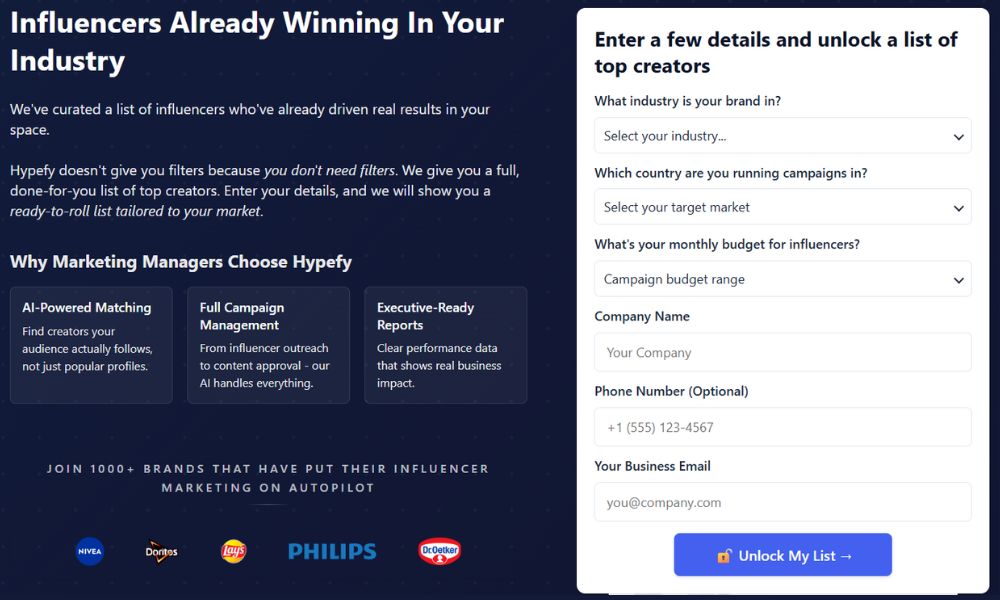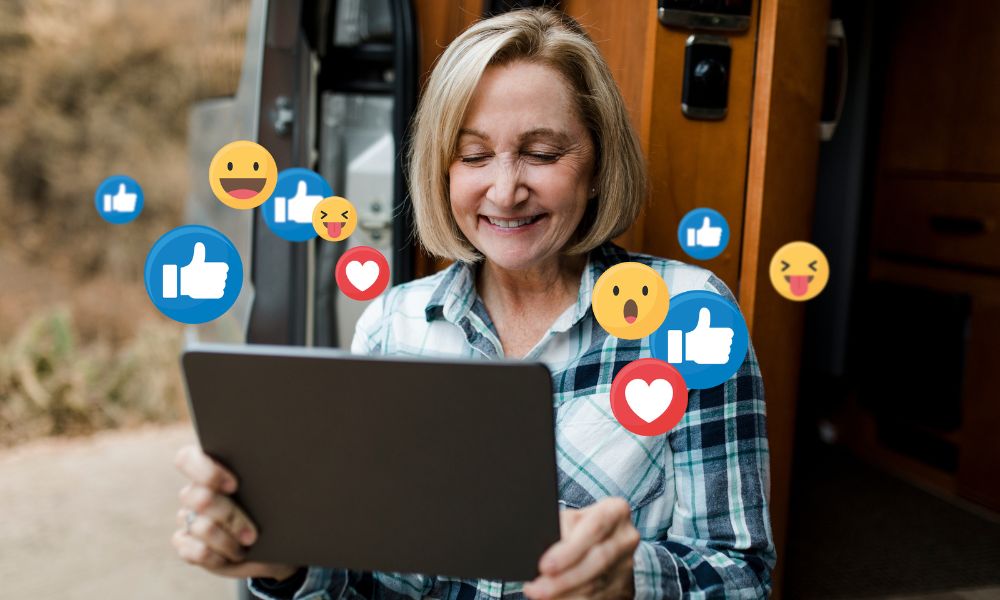Finding the right influencers for your brand isn’t just about follower counts, it’s about alignment. The right creator should speak to your audience, reflect your values, and help move the needle on real business goals. But with so many platforms and creators to choose from, knowing where to start can feel overwhelming.
In this guide, we’ll walk you through a clear, six-step strategy to find influencers who actually fit your brand. You’ll learn how to identify the right platforms, vet potential partners, use discovery tools effectively, and set up a repeatable process for future campaigns. We’ll also highlight some of the best influencer marketing tools to simplify your workflow.
Whether you’re building your first campaign or refining an existing strategy, this guide will give you a practical, scalable approach to influencer discovery.

Step #1 – Define Your Audience, Goals & Budget
Before you start searching for influencers, take a step back and clarify what success looks like. A clear strategy helps you filter out mismatched creators and focus on those who can truly support your goals. This foundation makes every step that follows faster, more focused, and more impactful.
a) Set Goals That Guide Your Search
Start by identifying what you’re hoping to achieve. Is the goal to:
- Raise awareness for a product launch?
- Drive traffic to a landing page?
- Generate user content for future ads?
- Boost sales through affiliate links?
Your goals will shape every decision, what platforms to focus on, what influencer tier makes sense, and how you measure results. Be specific. Instead of “get more reach,” aim for “reach 50,000 new potential customers in our target region.”
b) Know Who You Want to Influence
Instead of focusing only on the influencer, think first about their audience. Who are you trying to influence? Define key traits like:
- Age range
- Location or region
- Interests and values
- Buying behavior or pain points
Once you have this audience profile, look for influencers whose followers closely match that demographic. An influencer can have great engagement, but if their audience doesn’t align with yours, it won’t convert.
c) Set a Budget That Reflects Your Goals
Influencer costs vary widely. Nano creators may charge $100–$500 per post, while larger influencers or those in high-demand niches can command thousands. Your budget will help narrow the field and guide how many influencers to work with.
Don’t just think about content cost, also factor in time, management, and deliverables. And remember, it’s better to do a smaller campaign with the right fit than spread too thin with the wrong creators.
Your campaign type should align with your business goals. Explore the most effective types of influencer marketing campaigns to decide what works best for your brand.
Step #2 – Where to Find Influencers
Once you know who you’re trying to reach and what you want to achieve, the next step is finding the right creators. That starts with knowing where to look. Influencers are everywhere, but not every platform or tool gives you the same level of access, context, or quality.
a) Use Social Media Platforms to Discover Influencers
Sometimes, the simplest place to start is directly on the platforms your audience already uses.
Instagram & TikTok – Best for Lifestyle, Beauty, Fashion, and E-commerce
Use hashtags, location tags, and niche search terms to explore creators organically. Look at engagement quality, post consistency, and whether they work with other brands.
YouTube – Best for Long-Form Content, Tutorials & Product Reviews
Great for finding creators who do deep dives, like reviews, unboxings, and how-to content. Use YouTube search, sort by views or recency, and check if they include affiliate links or brand mentions.
LinkedIn – Best for B2B and Professional Services
Thought leaders, consultants, and niche experts often grow their followings through insights and case studies. Ideal for brands in SaaS, finance, or B2B marketing.
Twitter (X) – Best for Real-Time Reactions & Niche Communities
Look for active voices in niche spaces (tech, crypto, culture, journalism). Use search operators and hashtags to spot consistently engaging voices.
b) Use Social Listening Tools
If you want to monitor brand mentions, competitor shoutouts, or local influencer activity, social listening platforms are useful:
- Sprout Social – Tracks mentions, hashtags, and influencer engagement across platforms.
- Awario – Great for local or geo-specific influencer discovery based on real-time mentions.
These tools give you a broader view of who’s already talking about your brand, category, or products.
c) Set Up Search Alerts & Use Google Tools
Don’t underestimate free tools. Set up Google Alerts for keywords like “top fitness influencers in [your city]” or “best tech reviewers YouTube.” Also, try:
- Google News: See who’s being mentioned in the media
- Google Search: Combine niche + platform (e.g., “eco-friendly TikTok creators”)
- Google Trends: Explore rising categories and relevant creator niches
d) Use the Hypefy Influencer Platform
If you want a faster, smarter way to find creators who actually fit your brand, influencer platforms can simplify the entire process. Instead of manually searching through social profiles, you can filter by niche, audience, engagement, and more, all in one place.
At Hypefy, we offer two key tools to help you do just that:
- Influencer Discovery Tool – Search thousands of Instagram and TikTok creators by location, category, follower count, engagement rate, and more. It’s built for speed and accuracy, helping you find the right match without the guesswork.
- Influencer Match – Let our AI recommend creators who align with your brand’s values, audience, and campaign goals. Just describe your brand in a few lines, and we’ll handle the matching for you, no subscriptions or cold outreach are required.
If you want verified influencer profiles, real engagement insights, and a preview of campaign-ready matches, Hypefy gives you all of that in one dashboard.

Step #3 – Qualify & Vet Influencers
Not every influencer with high engagement or a good-looking feed is the right fit for your brand. Once you’ve built a shortlist, the next step is to vet each creator carefully. This stage is critical, it protects your budget, brand reputation, and campaign performance.
Here’s what to look for:
1. Audience Alignment
Make sure the influencer’s followers match your target audience, not just in size, but in relevance.
- Review audience demographics: age, gender, location, language
- Check interests and buying potential (where possible, through tools)
- Avoid creators with large but unaligned or international audiences if your campaign is local
2. Content Quality & Brand Fit
Scroll through recent posts. Ask yourself:
- Does their tone and style match your brand?
- Do they create original content or mostly repost?
- Are they already promoting too many brands (especially competitors)?
Look for consistency in voice, visuals, and values. The best collaborations feel natural to their audience, not like a forced ad read.
3. Engagement Quality
High follower counts mean little without genuine engagement. Check:
- Engagement rate (likes + comments ÷ followers)
- Comment quality: Are followers asking questions, tagging friends, or just dropping emojis?
- Signs of fake engagement, like repeated generic comments or sudden follower spikes
Tools like Hypefy, Modash, or HypeAuditor can help uncover real vs. inflated metrics.
4. Past Brand Collaborations
Check if they’ve worked with brands before. Look for:
- Evidence of professionalism: disclosures, clean visuals, on-brand messaging
- Repetition: Have they worked with the same brand more than once? That’s a good sign.
- Competitor conflicts: If they recently posted for a direct competitor, it might dilute your message
5. Authenticity & Reputation
Finally, take a look beyond the grid:
- What do their Stories, Reels, or livestreams look like?
- Do they respond to followers or just post and leave?
- Do they share personal values or content that could clash with your brand?
A polished profile is great, but authenticity, relatability, and trust matter more when it comes to conversions.

Step #4 – Organize, Prioritize & Compare Candidates
Once you’ve vetted your list of potential influencers, the next step is turning insights into action. A scattered list of good profiles isn’t enough, you need to organize them in a way that supports smart decisions, clear communication, and measurable outcomes.
a) Create a Shortlist & Scorecards
Narrow your list down to influencers who check the boxes for relevance, engagement, and brand fit. Then apply a simple scorecard system to help prioritize outreach.
You can rank each influencer using 3–5 criteria, such as:
- Audience match
- Engagement quality
- Content style
- Past brand experience
- Availability or responsiveness
Use a basic scale (e.g., 1–5) and total the score. This gives you a clearer view of who’s a strong lead versus a backup.
b) Understand Cost Per Engagement (CPE)
CPE is a quick, helpful metric to evaluate whether an influencer offers good value for money.
CPE = Total cost ÷ total expected engagements
For example, if an influencer charges $300 and averages 1,000 likes + comments per post, their CPE is $0.30. You can compare that across your shortlist to spot overpriced creators or hidden gems with strong performance at a lower cost.
💡 Note: A low CPE doesn’t always mean better, it depends on campaign goals. For conversions or niche audiences, a higher CPE may still be worth it.
c) Spreadsheet Tracking Tips
Even if you use a platform, you’ll likely need to track some details manually. A simple spreadsheet can go a long way in keeping your outreach and evaluation organized.
Useful columns to include:
- Influencer handle and platform
- Follower count and engagement rate
- Contact info or DM status
- Scorecard total
- Pricing (per post, story, package)
- Notes (brand fit, audience match, last outreach date)
Use filters to sort by engagement rate, cost, or score. Color coding can help you quickly separate “ready to pitch” vs. “needs follow-up.”
Step #5 – Outreach & Campaign Planning
Once you’ve identified and prioritized your ideal influencers, it’s time to make contact. But outreach isn’t just about getting a reply, it’s about building a professional relationship, aligning on expectations, and setting the stage for a campaign that delivers results.
a) Personalize Your Pitch
Avoid generic copy-paste messages. Influencers get dozens of pitches, and the fastest way to be ignored is to sound like a mass email.
Here’s what to include:
- Mention why you chose them (reference a post or shared value)
- Explain what your brand does in one line
- Keep it short and respectful of their time
- Include a soft call to action (e.g., “Would you be open to hearing more?”)
Whether you’re reaching out via DM or email, make it feel human, not transactional.
Tip: If you’re using Hypefy, you can skip cold outreach altogether by receiving pre-matched creators who are already open to partnerships.
If you need help crafting your message, check out our guide on how to reach out to influencers with 6 templates you can use.
b) Clear Collaboration Briefs
Once someone shows interest, it’s essential to share a well-structured brief that sets expectations. A good collaboration brief should include:
- Campaign goal and key message
- Content type and format (e.g., 1 Reel + 2 Stories)
- Platform(s) and post dates
- Brand guidelines (voice, hashtags, required tags)
- Compensation structure (flat rate, affiliate, product trade)
- Timeline for review, edits, and approvals
This saves time on back-and-forth and helps avoid miscommunication once content goes live.
c) Flexible Negotiation & Long-Term Relations
Not every influencer will say yes to your first offer, and that’s okay. Negotiation is normal, especially around content scope, timing, and rates. Be clear on your budget, but also open to finding win-win terms.
Also, think beyond the campaign:
- If an influencer delivers great content and results, consider making them a brand ambassador
- UGC rights can be negotiated up front if you plan to reuse content
- Keep notes on preferences, payment details, and past performance to make future collaborations smoother
The best influencer programs are built on trust, not one-off transactions.

Step #6 – Measure Results & Scale
Once your campaign is live, the real work begins, measuring what worked, what didn’t, and how to improve next time. Without solid tracking, it’s impossible to justify spend or scale your influencer strategy with confidence.
a) Track Key Metrics Based on Your Goal
Tie your results directly to the objective you set in Step #1. Here’s what to focus on:
- For awareness campaigns: Reach, impressions, views, follower growth, and branded hashtag use
- For engagement campaigns: Likes, comments, shares, saves, click-through rates
- For conversion campaigns: Promo code usage, link clicks, purchases, form submissions
Make sure you collect results from both your own analytics and any data influencers share (like Story views or affiliate reports).
b) Use Tools to Centralize Reporting
Platforms like Hypefy can automatically pull post data, engagement rates, and UGC performance into one place. If you’re managing manually, set up a tracking sheet that includes:
- Influencer handle
- Content links
- Metrics (views, likes, comments, etc.)
- Cost per post
- Cost per engagement or acquisition
- ROI estimation (if applicable)
Having everything in one dashboard or spreadsheet makes it easier to compare and optimize for future campaigns.
c) Repurpose What Works
If a piece of content performed well, reuse it. High-performing influencer posts can be:
- Republished as ads
- Turned into website or email content
- Included in product pages or testimonials
- Boosted through paid media for extended reach
Just make sure you’ve secured usage rights for repurposing (either up front or via a follow-up agreement).
d) Scale What’s Working
Once you know what platforms, creators, or content types perform best, double down:
- Re-engage top performers for new campaigns
- Test similar creators in related niches
- Expand into new regions or verticals using the same process
Scaling isn’t about doing more, it’s about doing more of what works. Once your campaign wraps, don’t just move on, review what worked, refine your approach, and document what to do differently next time. That’s how you scale effectively. And if you want to streamline that process from discovery to reporting, the right platform can make a big difference.
Why Learning to Find the Right Influencers Matters
With so many brands competing for attention, influencer marketing offers something more than exposure, it offers relevance and trust. But not every creator will move the needle for your business. Learning how to find, assess, and collaborate with the right influencers is one of the most valuable skills your marketing team can develop.
First: The Power of Influencer Marketing
Influencer marketing continues to outperform many traditional advertising methods. Consumers are more likely to trust recommendations from people they follow than ads they scroll past.
Here’s why it works:
- Influencers bridge the trust gap between brands and customers. A well-placed creator endorsement can feel more like a recommendation than a promotion.
- Platforms like Instagram, TikTok, and YouTube are built for discovery. Influencers don’t just speak to audiences, they move them.
- Influencers create content that performs. It’s often more relatable, visually creative, and platform-native than brand-produced content.
And it’s measurable. When planned and tracked properly, influencer marketing can deliver strong ROI, boost search traffic, increase conversions, and even support SEO through backlinks and brand mentions.
But without the right fit between brand and creator, the results fall flat. That’s why investing time in finding the right influencers is just as important as campaign strategy or creative direction.
Second: Benefits of Partnering with the Right Influencers
Not every creator will be a match for your brand, and that’s a good thing. When you find influencers who naturally align with your values, audience, and goals, the benefits go far beyond a single post.
Here’s what the right influencer partnerships unlock:
- Higher engagement and better reach: Their audience cares about the message, not just the messenger.
- Authenticity and brand trust: Content feels native to the creator’s style, increasing credibility and reducing ad fatigue.
- Stronger content performance: Influencers know what resonates with their audience, leading to more clicks, saves, shares, and conversions.
- Long-term collaboration potential: Repeat partnerships lead to better results, stronger brand loyalty, and more cost-effective campaigns.
- Access to niche audiences: Micro and nano influencers can drive focused impact where broader channels can’t reach.
When you get it right, the influencer doesn’t just promote your brand, they become part of it. And that starts by knowing how to find them.

Final Thoughts
Influencer marketing works best when it’s intentional, not rushed, not improvised. Taking the time to find creators who actually align with your brand pays off in ways that go beyond a single campaign. It leads to stronger content, better engagement, and partnerships you can build on.
When you know exactly who you’re targeting, what success looks like, and which creators align with your message, the results are measurable and repeatable.
This process doesn’t need to be overwhelming. With the right steps and a reliable tool, you can find influencers who are the right fit and create campaigns that actually drive growth.
👉 Try Hypefy to discover top creators from Instagram and TikTok, whether pre-vetted or sourced on demand, preview matches, and launch influencer campaigns faster, with no long-term commitment.



